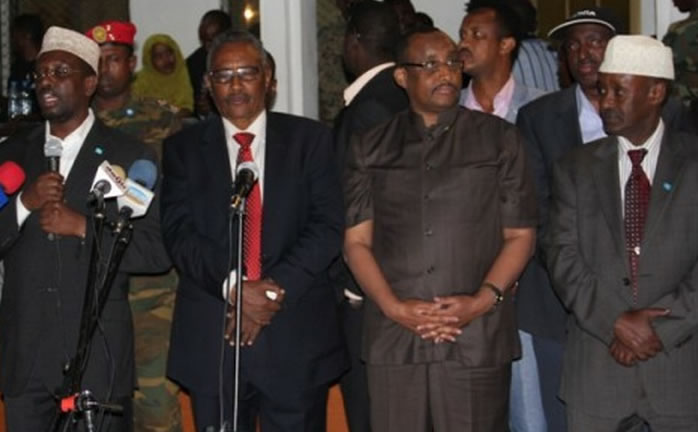by Abdirizak Omar Mohamed
Friday, June 22, 2012
There is a push to adopt a provisional federal constitution in Somalia when other important issues such as reconciliation, reconstruction and security remain a top priority for the country.
The proposed constitution, with its deficiencies, has more chances to exacerbate the situation in Somalia than to address the fundamental issues that led to the protracted conflict.
The Somali public have registered widely their opposition to the draft constitution not only that it represents the wrong diagnosis of federalism, but it also failed to accommodate the aspirations of the Somali people, including the unitary federalism that was founded on the Somali Republic in 1960 which merged both Northern and Southern Somalia into one nation.
A recap of that history in 1960 provides us an excellent blueprint of legitimate constitution-making process that successfully sailed the Somali people for nearly a decade in post-independence without experiencing major constitutional issues. With the euphoria of independence, the country immediately adopted a fair constitution that offered a decentralized governance system with strong popular support from the public who backed its referendum with landslide votes.
To capitalize on that experience, I propose two options for the current draft constitution to gain the support it requires from the Somali people to become a legal document that reunites the North and the South in this critical period to move the whole country into a new era of unity, prosperity and justice. The first option is to readopt wholly the 1960 constitution which has provisions of decentralization of power that can be used as a framework of federalism. This will give autonomy to regional states within the North and the South which exactly could address the call of federalism that resonates with the emerging new clan states across the country.
The second option is to make negotiated amendments on that constitution between the North and South to chart out a future that federates the Somali Republic and offers limited power and autonomy to regional states. The high-level delegations from the Transitional Federal Government of Somalia (TFG) and the secessionist state of Somaliland that recently met in London for the first time in 20 years should explore this option as a framework to renew the 1960 constitution and overcome the political stalemate in Somalia.
Moreover, the 1960 constitution has the potential to rectify the contentious political and power distribution issues that fueled the disintegration cycle within the various Somali political actors. With strong pool of technocrats, the constitution could be operationalized in all regions, which exactly was one of the key challenges that broke the balance between the regional and the central government of 1960.
As aptly expressed recently in a speech by the former Prime Minister, Abdirizak Haji Hussein, “It was not the system that failed, but the technocrats who were trained outside Somalia who were supposed to return to other regions in Somalia to promote regional autonomy and local governance”
Also, it was argued that the central government of 1960 was plagued by a short supply of administrators and mid level managers that increasingly limited its capacity and effectiveness. But that issue no longer exists because there are cadres of thousands of Somali professionals in the diaspora, who can easily be tapped when the political and the security environments in Somalia are addressed.
However, the current approach taken by the draft constitution paves the way for an open-ended segregation under tribal safe havens and clan enclaves. The inherent ambiguities within the UNDP-sponsored constitution for Somalia on clan boundaries and the equal status given each under the new federal constitution will make the system more unstable and prone to fail in the long term. In fact, the federal system in which the current leadership in Somalia has in mind is the chaotic one that we have witnessed in the recent Istanbul II conference on Somalia that presented four presidents, each representing a particular region of Somalia, including TFG, Galmudug, Somaliland and Puntland.

A viable constitution always has a room for improvements to ensure that it is capable to address the complex legal and social issues in the country. In the absence of federal states or clan regions in Somalia, adopting the 1960 constitution with some amendments remains a sensible alternative to those who want to see a genuine framework that could prevent unnecessary power wrangling in the future.
In this critical period of ending the transition, the Somali leaders should seize this opportunity to bring about a breakthrough in the bilateral negotiations between Somalia and Somaliland. The parties in the negotiation talks should understand that without serious concessions for the reunification of the country, Somalia will continue to fall deep into the abyss of chaos and darkness.
To finally rid itself of anarchy and violence, Somalia should adopt a system of federalism that is functional and would federate Southern and Northern Somalia. This system must accommodate the diverse clans within these two jurisdictional areas, where power is shared based on density and population. The proposed federalism, based on mini-fiefdom states, was established for convenience’s sake and will not work for a nation the size of Somalia.
Abdirizak Omar Mohamed
Is a political analyst and editor of Hiiraan Online, he can be reached at [email protected]